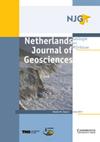荷兰地热井改造
IF 2.3
2区 地球科学
Q3 GEOSCIENCES, MULTIDISCIPLINARY
Netherlands Journal of Geosciences-Geologie En Mijnbouw
Pub Date : 2020-02-05
DOI:10.1017/njg.2019.8
引用次数: 4
摘要
水力压裂是一种建立已久的增产方法,旨在提高井的流入或流出潜力。水力压裂是油气行业使用的最成功的增产方法,在世界各地也被用于注水井和生产井,甚至是饮用水井。水力压裂在地面上产生裂缝,然后用高导电性材料(支撑剂)填充裂缝。与未压裂井相比,该裂缝具有更大的流入面积,并为流体流入或流出储层提供了高渗透率的通道。自20世纪80年代以来,水力压裂在热干岩(HDR)地热应用中有着悠久的历史(Murphy & Fehler, 1986)。在这些通常非常致密的储层中,目标是建立裂缝网络,以产生储层的流动能力。在高渗透率地层中,压裂有可能使井的产能翻倍。在低渗透地层中,在大多数情况下,井的性能可以提高5-10倍。在本文中,我们重点讨论了两种不同的地热增产方案。第一种是具有渗透性和多孔性的地层,在这种地层中,热交换是通过流体和多孔储层之间的完美接触进行的。如果由于储层渗透率不足,井附近的压降过大,则可能需要进行增产以形成一条小裂缝。另一种情况是,在深度较深的地层中,地层渗透率非常小,需要很长的支撑裂缝才能获得足够的流量,甚至在多孔系统无法提供足够的热交换的情况下,热交换必须通过人工或刺激的裂缝网络来促进,即所谓的增强型地热系统。对于多孔、渗透性地层,我们将介绍一些可以提高流量的压裂措施,从而提高项目的经济效益。在一些地层中,当储层质量低于预期时,增产措施是一种应急措施。在最坏情况下,表皮值为20的井可以像基本情况下未进行增产的井一样进行增产。在其他地层中,增产作业将是井设计中不可或缺的一部分,以优化项目性能。在这种情况下,增产措施可将增产系数从7提高到25。在超深层地热(UDG)开采中,目标是4000米以下的储层,因为工业热需求要求最低温度为120°C至250°C。对于经济商业案例,15至25年期间的速率应在150至450 m3 h−1之间,具体取决于边界条件。荷兰的浅层储层通常显示出非常高的渗透率,但在深度较大的目标层可能具有非常低的渗透率(Veldkamp等人,2018)。有几种增产方法可以使用,其中水(无支撑剂)水力压裂是主要的候选方法。其他增产方法包括砂岩支撑压裂、碳酸盐岩酸压裂和热增产。对于荷兰具有吸引力的UDG地质层,最可能的增产方法是水压裂,因为支撑压裂需要大量的支撑剂,成本非常高。在模拟和概念设计的基础上,对所选边界条件下的期望流量进行了估计。本文章由计算机程序翻译,如有差异,请以英文原文为准。
Stimulation for geothermal wells in the Netherlands
Abstract Hydraulic fracturing is a long-established method of stimulating a well to improve the inflow or outflow potential. Hydraulic fracturing is the most successful stimulation method used by the oil and gas industry, and is also used for water injection and production wells around the world, even for drinking-water wells. Hydraulic fracturing creates a crack in the earth that is then filled with a highly conductive material (proppant). This fracture has a large inflow area compared to an unstimulated wellbore and provides a high-permeability path for the fluid to flow in or out of the reservoir. Hydraulic fracturing has a long history of being used in hot dry rock (HDR) geothermal applications since the 1980s (Murphy & Fehler, 1986). In those often very tight reservoirs, the aim is to create fracture networks that generate the reservoir flow capacity. In high-permeability formations, fracturing can potentially double the productivity of a well. In low-permeability formations, well performance can be increased by a factor of 5–10 in most cases. In this paper, we focus on two different scenarios of geothermal stimulation. The first is for permeable, porous formations where the heat exchange happens through the perfect contact between the fluid and the porous reservoir. Stimulation may then be necessary to create a small fracture if the pressure drop near the well is too large due to insufficient reservoir permeability. The other scenario is a formation at great depth, where the formation permeability is so extremely small that very long propped fractures would be needed to obtain sufficient flow or even where the porous system does not provide sufficient heat exchange but the heat exchange has to be facilitated by an artificial or stimulated fracture network: a so-called Enhanced Geothermal System. For porous, permeable formations we will present examples of fracture treatments that can increase the flow rate so that the economics of the project is improved. In some formations, stimulation is then a contingency in case of poorer than expected reservoir quality. A worst-case well with a large skin value of 20 can perform with stimulation like a base-case unstimulated well. In other formations, stimulation will be integral to well design in order to optimise the project performance. For those cases the Coefficient of Performance can be improved from 7 to 25 with the aid of stimulation. In Ultra-Deep Geothermal (UDG) recovery, the targets are reservoirs below 4000 m, because industrial heat demand requires a minimum temperature of 120°C up to 250°C. For an economic business case, the rate over a period of 15 to 25 years should be from 150 to 450 m3 h−1, depending on the boundary conditions. Shallower reservoirs in the Netherlands often show very high permeability, but at great depth the target layers could have very low permeability (Veldkamp et al., 2018). Several stimulation methods can be used, of which hydraulic fracture stimulation with water (proppantless) is the primary candidate. Other stimulation methods are propped fracturing in sandstone, acid fracturing in carbonates and thermal stimulation. For a geological play that is attractive for UDG in the Netherlands, the most likely stimulation method is with water fracturing, because propped fracturing would require a huge amount of proppant that is very costly. Based on analogues and conceptual designs, the expected flow rate is estimated under selected boundary conditions.
求助全文
通过发布文献求助,成功后即可免费获取论文全文。
去求助
来源期刊
CiteScore
4.00
自引率
25.90%
发文量
14
审稿时长
>12 weeks
期刊介绍:
Netherlands Journal of Geosciences - Geologie en Mijnbouw is a fully open access journal which publishes papers on all aspects of geoscience, providing they are of international interest and quality. As the official publication of the ''Netherlands Journal of Geosciences'' Foundation the journal publishes new and significant research in geosciences with a regional focus on the Netherlands, the North Sea region and relevant adjacent areas. A wide range of topics within the geosciences are covered in the journal, including "geology, physical geography, geophyics, (geo-)archeology, paleontology, hydro(geo)logy, hydrocarbon exploration, modelling and visualisation."
The journal is a continuation of Geologie and Mijnbouw (published by the Royal Geological and Mining Society of the Netherlands, KNGMG) and Mededelingen Nederlands Instituut voor Toegepaste Geowetenschappen (published by TNO Geological Survey of the Netherlands). The journal is published in full colour.

 求助内容:
求助内容: 应助结果提醒方式:
应助结果提醒方式:


